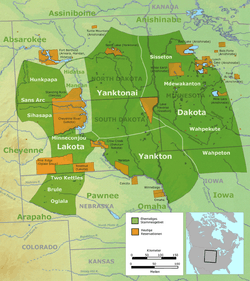Fort Berthold Indian Reservation

The Fort Berthold Indian Reservation is a U.S. Indian reservation in western North Dakota that is home for the federally recognized Mandan, Hidatsa, and Arikara Nation, also known as the Three Affiliated Tribes. The reservation includes lands on both sides of the Missouri River.
Created in 1870, the reservation is a small part of the lands originally reserved to the tribes by the Fort Laramie Treaty of 1851, which allocated nearly 12 million acres (49,000 km²) in North Dakota, South Dakota, Montana, Nebraska and Wyoming.[1][2]
Location
The reservation is located on the Missouri River in (in descending order of reservation land) McLean, Mountrail, Dunn, McKenzie, Mercer and Ward counties. The reservation consists of 988,000 acres (4,000 km²), of which 457,837 acres (1,853 km²) are owned by Native Americans, either as individual allotments or communally by the tribe.[3] The McLean National Wildlife Refuge lies within its boundaries.
The Four Bears Bridge, which opened in 2005 replacing the original 1955 Four Bears Bridge, provides access across Lake Sakakawea.[4]
History
Created in 1870 by the U.S. government, the reservation was named after Fort Berthold, a United States Army fort, located on the northern bank of the Missouri River some twenty miles downstream (southeast) from the mouth of the Little Missouri River.[5]
In the late nineteenth and early twentieth century. the US government assigned individual allotments of land to householders from communal holdings. The government was trying to encourage the tribal members to take up subsistence farming in the European-American style. The tribe retained some communal holdings and, since its reorganization in the 1930s, has resisted distribution of individual allotments.
The population of the reservation was 6,341 as of the 2010 census. The Tribe reported a total enrollment of 15,013 registered tribe members in March 2016.[6][7] Unemployment was at 42%. The 2000 census reported a reservation population of 5,915 persons living on a land area of 1,318.895 sq mi (3,415.923 km²).
The creation of Garrison Dam between 1947–53 and Lake Sakakawea as water reservoir for irrigation, for flood control, and hydroelectric power generation in 1956, increased the proportion of water area on the reservation. It totals 263.778 sq mi (683.182 km²) or one-sixth of the reservation's surface area.[8][9] The lake caused the flooding of large areas of tribal lands devoted to farming and ranching, destroying much of the Three Affiliated Tribes’ economy.[10]
Communities
The largest communities of the reservation are the towns of New Town and Parshall. The tribe operates 4 Bears Casino and Lodge in New Town, which was built in 1993.[11]
Communities are:
References
- ↑ "Tribal Historical Overview - The 1851 Fort Laramie Treaty". www.ndstudies.org. Retrieved August 1, 2016.
- ↑ "Three Affiliated - Demographics - Land Base and Land Status". www.ndstudies.org. Retrieved August 1, 2016.
- ↑ "Three Affiliated - Demographics - Land Base and Land Status". www.ndstudies.org. Retrieved August 1, 2016.
- ↑ "Four Bears Steadily Crosses Sakakawea in ND". www.constructionequipmentguide.com. Retrieved August 1, 2016.
- ↑ South Dakota State Historical Society, South Dakota. Dept. of History (1908). South Dakota Historical Collections. South Dakota State Historical Society. p. 235.
- ↑ "Demographics | North Dakota Studies". ndstudies.gov. Retrieved August 1, 2016.
- ↑ Sevant, Taft (March 30, 2016). "Three Affiliated Tribes Mandan, Hidatsa, and Arikara Nation Office of Tribal Enrollment" (PDF). mhanation.com. Retrieved August 1, 2016.
- ↑ Lake Sakakawea History McLean County
- ↑ Coyote Warrior: One Man, Three Tribes, and the Trial That Forged a Nation, Second Edition by Paul VanDevelder https://books.google.com/books/about/Coyote_Warrior.html?id=B3B0aYwTzRYC
- ↑
- ↑ "4 Bears Casino & Lodge". www.worldcasinodirectory.com. Retrieved August 1, 2016.
External links
| Wikimedia Commons has media related to Fort Berthold Indian Reservation. |
- Official website of the Mandan, Hidatsa, and Arikara Nation, also known as the Three Affiliated Tribes.
- Fort Berthold Reservation, North Dakota United States Census Bureau
Coordinates: 47°44′35″N 102°16′39″W / 47.74306°N 102.27750°W